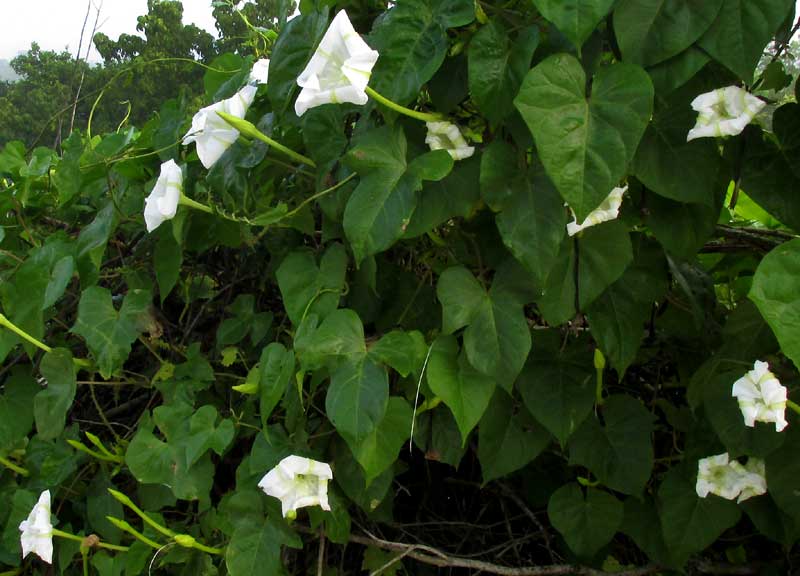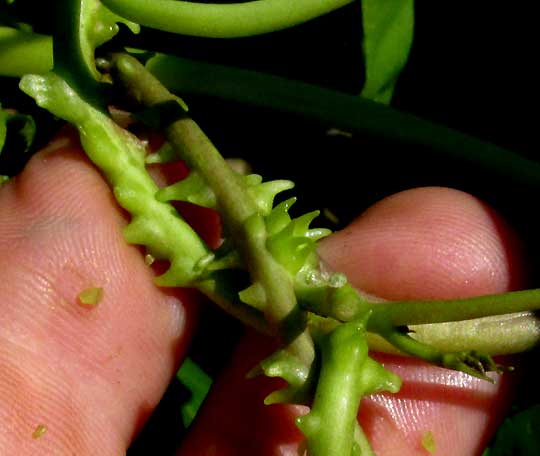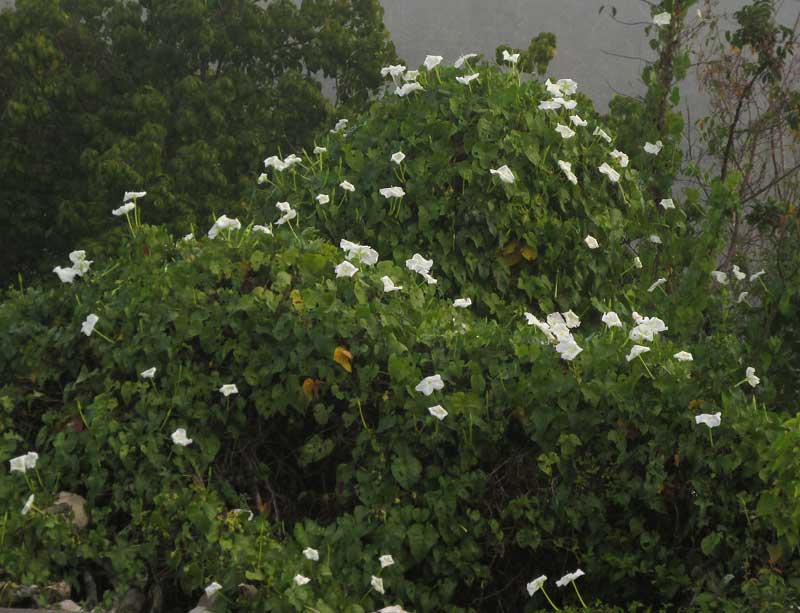Excerpts from Jim Conrad's
Naturalist Newsletter

from the November 15, 2015 Newsletter issued from Hacienda Chichen Resort beside Chichén Itzá Ruins, central Yucatán, MÉXICO
MOONFLOWER
In the summer of 2003 I was living as a hermit in the piney woods near Natchez, Mississippi, next to a tangle of Moonflower vines cascading over a barn door. Several plants with large, white blossoms that open at night bear the Moonflower name, but the one I'm talking about is a member of the Morning Glory Family, IPOMOEA ALBA.
In that year's August 24 Newsletter I wrote that "The Moonflower knows how to build up suspense as the moment of blooming approaches. For several days you are impressed by the development of the large, green flower-bud."
Then I passed on my notes from a highly anticipated Moonflower blossoming:
"By Tuesday evening my bud had grown to exactly 6 inches long (15 cm). An hour before sunset the bud's spiraling pleats began bulging, revealing streaks of the flower's pure whiteness within. I placed my rocking chair next to the 17-ft-high vine (5 m) and waited. At first the blossom's opening proceeded too slowly to see, but, finally, exactly as the sun slipped below the horizon, and the flower was held closed only by the tips of its petals, suddenly the tips came loose all at once and the flower partially opened instantly, releasing a puff of perfume that almost staggered me."
"At dawn the next morning the flower's corolla closed like a crumpled paper bag. All day it remained shut beneath the bright sun, then an hour or two before dusk it fell off, leaving the ovary to develop into a fruit. That evening, Wednesday, two more blossoms opened, and I've had one to four blossoms each night since."
I'm not the only one who savors Moonflower openings. Ana María, a Newsletter reader in the Yucatán -- and the first to invite me here for what became a long-term presence -- wrote to me about her own experiences with Moonflower watching.
"On the night she expected her first bloom," I reported in the Newsletter, "she invited friends to experience the opening. They had a fine supper, then went out to see the opening -- and the entire flower bud that was supposed to open had been eaten by caterpillars! However, in two nights there was another bud to watch, and once again the friends came, there was a delicious meal topped off with an exquisite tarta de manzanas, or apple tart, and this time the blossoming surpassed expectations."
This week these memories flashed through my mind the moment a rampant tangle of wild Moonflower vine turned up along the road between the Hacienda and neighboring Xcalacoop. It was just a little after dawn on a foggy morning, with the pale sky only hinting that the sun might be above the horizon, yet already the vines' big blossoms were puckinger in their corollas, as shown at the top of this page.
In that picture, notice that some leaves are heart-shaped with no lobes or teeth, while others are deeply lobed. Leaves of wild plants are very variable, being 0-5 lobed. A picture of a gigantic flower bud that surely would open the following night, with my hand as scale, is shown below:

Because the Morning Glory Family, the Convolvulaceae, is so big, and so many species occur in Mexico, often it's hard to figure out which species you have. However, Moonflower vines display such distinctive features that they're easy to recognize. Besides the huge blossoms that open at night and close in early mornings, and stamens that extend beyond the corolla's center hole -- the stamens of most species hide within the corolla tube -- one good field mark is that the calyx's outer sepals bear on their backs long, slender, fleshy projections such as those shown below on calyxes from which the flowers have fallen:

Another is that the stems below where the flower clusters attach normally bear low, blunt teeth such as those shown below:

Though Moonflowers grow wild throughout Mexico and Latin America, as well as the US Southeast, it's hard to say where they originated. For their beauty they have been planted all over the world and in warmer lands have often escaped, giving the appearance of being a native plant. Linnaeus first described the species in 1753, using a plant from India.
from the December 20, 2015 Newsletter issued from Hacienda Chichen Resort beside Chichén Itzá Ruins, central Yucatán, MÉXICO
PROPAGATING MOONFLOWER
I want to plant morning glory vines around my hut, have them climbing into the trees and providing walls of brightly colored, fragrant flowers attracting butterflies, moths and hummingbirds. Nowadays the various morning glory species are beginning to produce mature fruiting pods, so I've been out collecting them.
My main target has been the Moonflower, whose seeds, mostly three to the capsule, are hard and large, as shown next to an open capsule in my hand at:

Noticing the seeds' hardness, I suspected that getting them to germinate might be a challenge. Maybe I'd need to scratch the seed coverings with a knife, or soak them in vinegar. I shouldn't have worried. With no preparation other than planting them shallowly in a container of loose, moist soil, already a strong, white root, the radicle, was emerging after only three days! After five days already the seedcoat had fallen off and the cotyledons were unfurled.
Moreover, while collecting Moonflower seeds along the road, I noticed that not only were the vines climbing high into trees, but also they were sending runners across limestone fill dumped there recently as the highway was widened. Below you can see these vigorous, flowering runners:

In other species, sometimes such runners root at the nodes where leaves are produced, so I began checking these for rooting nodes. For the most part the runners didn't root, but some of them did, especially where rain had washed silt over them, or the road crew had dropped a rock atop them. In these places vigorous roots were formed, as shown below on a dropped-rock-crooked stem section gnawed from a runner:

That rooting section was carried home, planted in moist soil, and never even wilted. Now it grows lustily in my pot and I plan to return and collect more such rooting sections for the Hacienda to have on hand.
So, Moonflower seeds are easy to germinate, but an even easier and faster way to get a Moonflower vine growing is to look for rooting runners.
from the March 13, 2016 Newsletter issued from Hacienda Chichen Resort beside Chichén Itzá Ruins; limestone bedrock; elevation ~39m (~128ft), N20.675°, W88.569°; central Yucatán state, MÉXICO
MOONFLOWER GETTING AGGRESSIVE
Nowadays Moonflower vines near the Hacienda are growing over and shading all bushes and small trees in their vicinity, just like Kudzu back in Mississippi. And early on a foggy morning, the open blossoms, which earlier shriveled at the first light of dawn, remained open until around 10 AM, as shown below:

I'd read that Moonflower could be invasive and choke out other plants, but until now it was hard to believe.